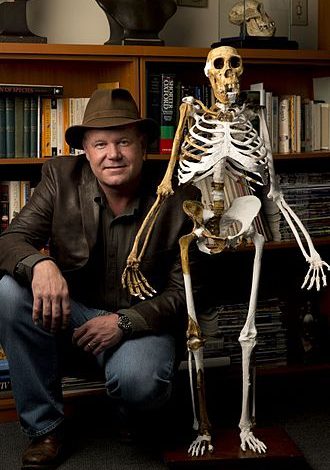Lee Rogers Berger

Lee Rogers Berger (born December 22, 1965) is an American-born South African paleoanthropologist and National Geographic Explorer-in-Residence.[1][2][3] He is best known for his discovery of the Australopithecus sediba type site, Malapa;[4] his leadership of Rising Star Expedition in the excavation of Homo naledi at Rising Star Cave;[5] and the Taung Bird of Prey Hypothesis.[6][7]
Berger is known not only for his discoveries, but also for his unusually public persona in paleoanthropology, and for making his most notable discoveries open-access projects. He makes hundreds of talks per year, and has had a close relationship with National Geographic for many years, appearing in several of their shows and documentaries.[8]
Berger was born in Shawnee Mission, Kansas in 1965, but was raised outside of Sylvania, Georgia in the United States.[9][10] As a youth, Berger was active in the Boy Scouts, Future Farmers of America, and president of Georgia 4-H. In 1984, Berger was named Georgia’s Youth Conservationist of the Year for his work in conserving the threatened gopher tortoise. He is a Distinguished Eagle Scout, and received the Boy Scouts of America Honor Medal for saving a life in 1987.[11][12]
He graduated from Georgia Southern University in 1989 with a degree in anthropology/archaeology and a minor in geology.
He undertook doctoral studies in palaeoanthropology at the University of the Witwatersrand (Wits) in South Africa under Professor Phillip Tobias, focusing his research on the shoulder girdle of early hominins; he graduated in 1994. In 1991, he began his long term work at the Gladysvale site. This marked the same year that his team discovered the first early hominin remains from the site, making Gladysvale the first new early hominin site to be discovered in South Africa since 1948.[13] In 1993, he was appointed to the position of research officer in the Paleo-Anthropology Research Unit (PARU) (now the Evolutionary Sciences Institute; ESI) at Wits.
He became a postdoctoral research fellow and research officer at the University of the Witwatersrand in 1995. He has been the leader of the Palaeoanthropology Research Group and has taken charge of fossil hominin excavations, including Sterkfontein, Swartkrans, and Gladysvale. In 2004, he was promoted to Reader in Human Evolution and the Public Understanding of Science. He is presently a research professor in the same topic at the Evolutionary Studies Institute (ESI) and the Centre of Excellence in Palaeosciences (CoE Pal) at Wits.
